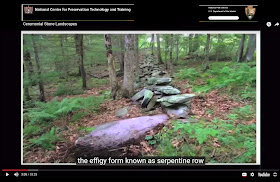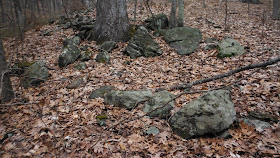Qusukqaniyutôkansh (pl): Rows of Stacked Stones,
colloquially “stone walls” or “stone
fences,” often assumed to be post contact constructions related to property
ownership and agriculture.
Listening to the Sound of Distant Thunder; Angry Voice of the Great Serpent: https://wakinguponturtleisland.blogspot.com/2007/06/im-listening-to-sound-of-thunder-in.html
This boulder should have been a clue, down at the northwestern end of this enclosed space, the zigzag remains of that same stone row that bounds that floodplain field by the Nonnewaug Stone Fish Weir on the eastern edge, the old Indian Trail on the western side, another boulder, perhaps humanly enhanced to resemble the head of a timber rattlesnake and the Great Serpent as well - a little fanciful with a rhomboidal shape for the the Snakes left eye:
Zigzag rows of stone aren't rare in the immediate area. A short drive away is this one, similar but not identical, just one more example of zigzag stacked to resemble entwined snakes - timber rattlesnakes with flat-topped triangular heads most often:
Sometimes these snakes are realistic, sometimes not - and they aren't always boulders.
Maybe it's a slightly larger cobble.
Sometimes something about the stone, especially something about the shape of the eye already there rather than pecked into it:
Sometimes the zigzag turns linear, maybe even turns a corner and maybe the Serpent Head is not very triangular or flat on top:
Sometimes there's a sort of Trompe l'oeil ('trick of the eye') to some of them and the Serpent, just like so many do in Great Serpent Stories, seems to change into something else as you walk around it:
Sometimes that Serpent Head will be at a slight (zigzag?) angle, and perhaps it recalls the Uktena, the Strong Looker, who knows your thoughts and intentions, who offers protection with the gift of tobacco, from the Thunder Beings who shoot fire from their eyes - and from the Great Serpent itself:
No, I just didn't have all these images fitted into my cognitive map back in 2007, just didn't know all those Great Serpent Stories I've been collecting now for sometime.
But I'm trying to learn how to listen better as the Landscape Speaks to me...
Adding this in January 2020:
In Stone Prayers; Native American Stone
Constructions of the Eastern Seaboard (2018), Dr. Curtiss Hoffman writes about
Qusukqaniyutôk or Stone Rows as Snake Effigies:
“Some of the more remarkable rows have what appear to be serpent heads at their
ends. These and the sinuous walls have been reclassified to the “effigies”
category (page 61)…It is my understanding that the Algonquin term qusukaniyutak, which applies to stone
rows and enclosures, also may be used to define serpentine walls. The Algonquin
term for snake, skug, does not appear
to be applied to these structures (page
92).”


























































